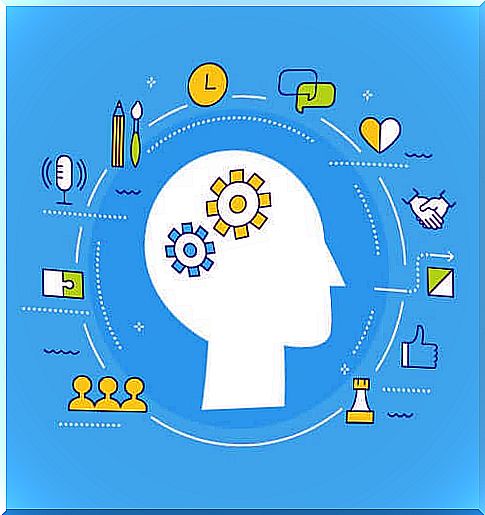Theory Of Multiple Intelligences: What Does It Tell Us?

The theory of multiple intelligences owes its birth to Howard Gardner, who in his book Frames of Mind (1983) expands the concept of intelligence and describes different types of intellectual abilities.
He identified 8 distinct types and explained that we can all possess these intelligences, even more than one. People differ from each other by life experiences or by genetic characteristics but, in any case, it is important to know these skills in order to develop them.
The theory of multiple intelligences

Linguistic-verbal intelligence
Linguistic or linguistic-verbal intelligence is part of Howard Gardner’s theory of multiple intelligences and refers to sensitivity to spoken and written language, the ability to learn languages and the ability to use language to achieve certain goals.
Thus, people with linguistic intelligence – such as William Shakespeare and Oprah Winfrey – are able to analyze information and create products that involve both oral and written language: speeches, books and memoranda.
Possible career opportunities:
- Lawyer.
- Deputy.
- Writer.
- Journalist.
- Teacher.
Logical-mathematical intelligence
On the other hand, logical-mathematical intelligence refers to the ability to analyze problems in a logical way or, to perform mathematical operations and to delve into topics in a scientific way. People with logical-mathematical intelligence – such as Albert Einstein and Bill Gates – have the ability to solve equations and tests, do calculations and solve abstract problems.
Possible career opportunities:
- Mathematical.
- Accountant.
- Statistician.
- Scientist.
- Computer scientist.
- Engineer.
Spatial intelligence and multiple intelligence theory
Spatial intelligence indicates the ability to identify and know how to manage both the models of an extended space (for example, those used by pilots and sailors), and the models of limited areas, such as those important for sculptors, surgeons, players of chess, graphic designers, artists or architects.
People with spatial intelligence – such as Frank Lloyd Wright and Amelia Earhart – have the ability to recognize and manage detailed, large-scale spatial images. Without a doubt, great potential.
Possible career opportunities:
- Pilot.
- Surgeon.
- Architect.
- Graphic designer.
- Interior decorator.
Body-kinesthetic intelligence
Bodily-kinesthetic intelligence is the potential with which we use the whole body or parts of the body (such as the hand or mouth) to solve problems or to create products.
People with body-kinesthetic intelligence – such as Michael Jordan and Simone Biles – have the ability to use their bodies to create products, implement skills or solve problems through the body-mind union.
Possible career opportunities:
- Dancer.
- Athlete.
- Surgeon.
- Mechanic.
- Carpenter.
- Physiotherapist.

Musical intelligence
Furthermore, musical intelligence refers to the ability to interpret, compose and know how to appreciate musical models. People with musical intelligence – such as Beethoven and Ed Sheeran – have the ability to recognize and create a tone, a rhythm or even a musical timbre.
Possible career opportunities:
- Singer.
- Composer.
- Dj.
- Musician.
Interpersonal intelligence
Interpersonal intelligence is the ability to understand other people’s intentions, motivations and desires and, therefore, to work efficiently with others.
Furthermore, people with interpersonal intelligence, such as Mahatma Gandhi and Mother Teresa, have the ability to perceive and understand the mood, desires, motivations and intentions of other people.
Possible career opportunities:
- Teacher.
- Psychologist.
- Manager.
- Commercial.
- Public relations.
The theory of multiple intelligences and intrapersonal intelligence
Intrapersonal intelligence means the ability to understand oneself, to have an effective working model, made up of one’s ambitions, fears and abilities, and to use that information effectively to manage one’s life.
On the other hand, people with intrapersonal intelligence – such as Aristotle and Maya Angelou – possess the ability to recognize and understand their moods, their desires, motivations and intentions that move them. Additionally, this type of intelligence can help people understand which life goals matter most to them and how to achieve them.
Possible career opportunities:
- Therapist.
- Psychologist.
- Business owner.

Naturalist intelligence
Naturalist intelligence involves experience in knowing how to recognize and classify the different species belonging to the flora and fauna of our environment. People with naturalistic intelligence – such as Charles Darwin and Jane Goddall – have the ability to identify and distinguish the different types of plants, animals and weather formations that we can find in nature.
Possible career opportunities:
- Botany expert.
- Biologist.
- Astronomer.
- Meteorologist.
- Geologist.
Now that you know the 8 intelligences identified by Gadner you may have recognized yourself in one of them or in more than one. Or, you may even have recognized them in your children.
In any case, what matters is to always follow the instinct in learning, in order to develop your potential to the maximum.









